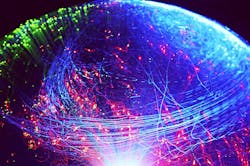The Most Important Developments in Fiber Optics
Key Highlights
- Optical fiber had been used for years for transmitting light and images, but it was not until 1966 that Dr. Charles Kao at STL in the United Kingdom proposed the way to make low-loss fiber suitable for communications.
- Mass deployment of optical communications had to wait until singlemode fiber became available in the early 1980s.
- Another invention proved to be a crucial part of the fiber optic cable plant puzzle: the connector needed to make reliable connections for singlemode fiber.
The breakthroughs that built today’s high-speed networks.
It was almost 50 years ago that I was given a tour of Bell Labs in Murray Hill, New Jersey, where they were developing fiber optics for communications. My guide was one of the researchers there, Dr. Tingye Li, who was also the Director of Lightwave R&D. The reason for the tour was to introduce me to the technology of fiber optic communications that was being developed at the labs and to entice the tech company I worked for, a major supplier to AT&T and Western Electric, to work with them to develop production equipment for fiber optic components and field test gear for installation techs.
Li was obviously proud of his job and the people working at Bell Labs. I remember walking down one hallway with him as he pointed out that this office and that one and that one belonged to a winner of the Nobel Prize, and this other office even had two Nobel Prize winners! As a physicist by education, I was thrilled, but also convinced that what I saw there was the future of communications. I’ve been involved in fiber optics ever since.
I was recalling my memories of the visits to Bell Labs recently when I was being interviewed by an author working on a new book about the history of fiber optics. In our conversations, I explained what I thought were the most important technological developments over the history of fiber optics that got us to where we are today. I will share that with you and a few thoughts about what I think may be those that drive the future of optical communications.
Mass deployment of optical communications had to wait until singlemode fiber became available in the early 1980s.
Optical Fibers for Communications
Optical fiber had been used for years for transmitting light and images, but it was not until 1966 that Dr. Charles Kao at STL in the United Kingdom proposed the way to make low-loss fiber suitable for communications. It eventually won him a Nobel Prize. It took six more years for Corning to devise a way to make low-loss fibers and another decade for the manufacturing processes to be refined so that singlemode fiber became readily available.
That singlemode fiber of 40 years ago is practically the same as the fiber used today. When I was first visiting Bell Labs, the only fiber they had was multimode, but they told me that they needed the higher bandwidth and lower attenuation of singlemode fiber for more speed and longer links. Mass deployment of optical communications had to wait until singlemode fiber became available in the early 1980s.
Semiconductors — Solid State Lasers and Telecom ICs
Communications over optical fibers needed high-power transmitters that could be modulated for data rates of millions of bits per second, and that required solid state lasers. Early lasers were fast enough, but the solid-state physics needed to be developed that allowed tailoring the laser wavelength to work in singlemode optical fiber. Numerous labs, including Bell Labs, worked during the 1970s and early 80s to perfect these devices.
Often overlooked in the development of fiber optics is the semiconductors that made the conversion of analog POTS signals on copper to digital logic signals for fiber optics. The breakthrough came in the late 1970s when semiconductor companies developed semiconductor analog-to-digital (A-D) and digital-to-analog (D-A) converters on a single chip that could replace large, expensive modules required at the time. I spent a year travelling the world teaching telcos and their suppliers about digital phone systems and the semiconductors that made it possible.
Fiber Optic Connectors
Another invention proved to be a crucial part of the fiber optic cable plant puzzle: the connector needed to make reliable connections for singlemode fiber. The precision needed was too high for early connectors. The AT&T Biconic connector worked for multimode fiber, but to adapt it for singlemode required a complex process that included grinding the Biconic ferrule to center the fiber adequately for singlemode. Other machined and molded connectors could not produce low-loss connections. The connector problem was solved by the invention of the molded ceramic connector ferrule in Japan. The connectors that became available in the mid-1980s proved to be perfect for connecting singlemode fibers. And they still are.
By the mid-1980s, fiber optic technology had matured adequately for telcos to begin mass conversion to fiber. It was not the technology that drove building fiber optic networks; it was economics. Transmitting data on fiber cost less than 5% as much as copper and microwave alternatives because fiber had hundreds of times as much bandwidth and more than ten times the distance capability. At the time, copper wires were limited to 1.5 megabits per second over links about 1.5 miles long. The very first fiber links operated at 145 megabits/second and more than 15 miles between repeaters. That is a distance-bandwidth advantage of 1,000 times!
Telcos began converting long-distance links first, then moved to metropolitan networks. Starting with TAT-8 in 1988, submarine fiber optic cables started connecting the continents and replacing satellites. Fiber-to-the-home (FTTH) was tested but proved to be much too expensive with the technology available at that time.
Fiber found other applications in computer networks, utility grids and even sensors. Fiber optic gyros guided airplanes and missiles. Fiber sensors measured high voltages and currents for controlling electrical grids. Networks of super-sensitive fiber optic microphones were installed along the coasts to listen for enemy ships and submarines.
The next few years were devoted to installing fiber. Technology was still being developed, much of it in communications equipment, where higher speeds were developed to take advantage of the capacity of optical fiber. But in the early 90s, three new interrelated technologies were developed that were very important to the development of fiber optics and broadband networks. One of the researchers contributing to these next developments was Dr. Tingye Li, as stated earlier, my guide at Bell Labs.
Fiber Amplifiers
Fiber amplifiers convert a short section of special optical fiber into a laser, amplifying any signal traversing it, making them ideal for repeaters or regenerators for long-distance networks. Before fiber amps, a repeater was a complex component comprised of a receiver to convert the incoming optical signal into an electronic signal, circuitry to filter out noise, amplify, and reshape the signal, and then a transmitter to convert it back into an optical signal. A simple fiber amp with a couple of fibers and one laser to pump the amplifier was simpler, cheaper and much more reliable.
DFB lasers, fiber amps and DWDM combined to greatly expand the already massive distance and bandwidth capabilities of fiber optic communications.
Wavelength Division Multiplexing (WDM)
The concept of transmitting multiple signals on one fiber simultaneously goes back to the beginnings of fiber optics. The first AT&T backbones on the East and West coasts began with 850 nm lasers but were designed to add a second wavelength, 1310 nm, when those lasers became available. The conversion to singlemode changed the wavelengths and the components required for multiplexing on singlemode needed development. Perhaps the most important development for WDM was the lasers needed.
Distributed Feedback Lasers (DFB)
DFB lasers used some optoelectronic and semiconductor tricks to better control the wavelength and line width of the laser. With precisely chosen lasers, more wavelengths could be carried in a single fiber, making Dense Wavelength Division Multiplexing (DWDM) capable of putting more than a hundred signals on a single fiber. DFB lasers, fiber amps and DWDM combined to greatly expand the already massive distance and bandwidth capabilities of fiber optic communications.
But DFB lasers had another unique characteristic—the ability to convert analog signals to optical signals while maintaining the quality of the analog signal—that had at least as large an effect in another area of communications: cable TV or CATV. CATV sent TV over coax cables using analog signals, putting TV channels at different frequencies on a cable instead of the radio waves used in broadcast TV. DFB lasers allow CATV to convert to hybrid fiber coax (HFC) networks simply, enhancing reliability and expanding the physical coverage area of their networks.
All this was occurring as the internet became available to the public. The internet needed a comprehensive fiber network as a backbone, but individual subscribers were limited to slow speeds using modems over POTS lines. Another important development, the cable modem, allowed CATV companies to use their “broadband” HFC networks to deliver fast, always-on internet connections, leading to the dominance of CATV companies in the delivery of internet service until the emergence of our next major development.
Passive Optical Networks (PONs)
Passive optical networks replace electronic switching with optical couplers and send signals bidirectionally over a single fiber. While the first optical LAN (computer local area network) used this concept in the 1980s, it was not until the early 2000s that singlemode PONs were adopted for FTTH. Today, most FTTH networks use PONs to connect hundreds of millions of users.
Bend Insensitive Fibers
With a slight modification of the optical structure of a fiber, light lost by macrobending can be guided back into the core of the fiber, allowing fibers to be bent around smaller corners or crowded tightly into a cable without adding attenuation. This development led to microcables, small enough to blow into microducts, and high fiber count cables, typically up to 1728 fibers for OSP networks in metro areas and 6912 fibers for data center interconnect.
Coherent Networks
A lot of fancy engineering and maybe a little bit of magic have led to transceivers that make 100 gigabits per second and above routine. And like everything else, over time they have shrunk in size and price to the point they are being used everywhere.
What’s Next?
Hollow core fibers allow signals to go from point to point 50% faster than glass fibers, and multicore fibers add capacity to a single fiber. Both are beginning to be used for special applications, but may prove to be the choice for next-generation networks. Other proposed technologies involve quantum theory, entangled particles and other ideas that really seem more like magic, until they become practical.
Even after nearly 50 years in the business, I can still say fiber optics is never boring!
About the Author
Jim Hayes
Fiber Optic Expert
Jim Hayes is the Fiber Optic Expert columnist for ISE Magazine. He is a lifelong techie who has been involved in the fiber optic industry since the late 1970s. He founded one of the world's first fiber optic test equipment companies, FOTEC, which was acquired by Fluke in 2000, and he was a co-founder of the Fiber Optic Association (FOA), the international professional society of fiber optics, in 1995.
Jim is a writer and trainer and the President of FOA. He is the author of nine books on fiber optics and cabling and writes for several magazines.
Jim and his wife, Karen, who is the GM of the FOA, have traveled the world for the FOA helping set up schools to train the workers who design, build, and operate today's communications networks. The FOA offers nearly 1,000 pages of online technical materials, over 100 videos, and two dozen free self-study courses online.
For more information, email [email protected] or visit www.jimhayes.com.
To learn more about The Fiber Optic Association, visit www.thefoa.org. Follow them on Facebook: FiberOpticAssociation, LinkedIn: company/the-fiber-optic-association-inc-foa, and YouTube: user/thefoainc.

